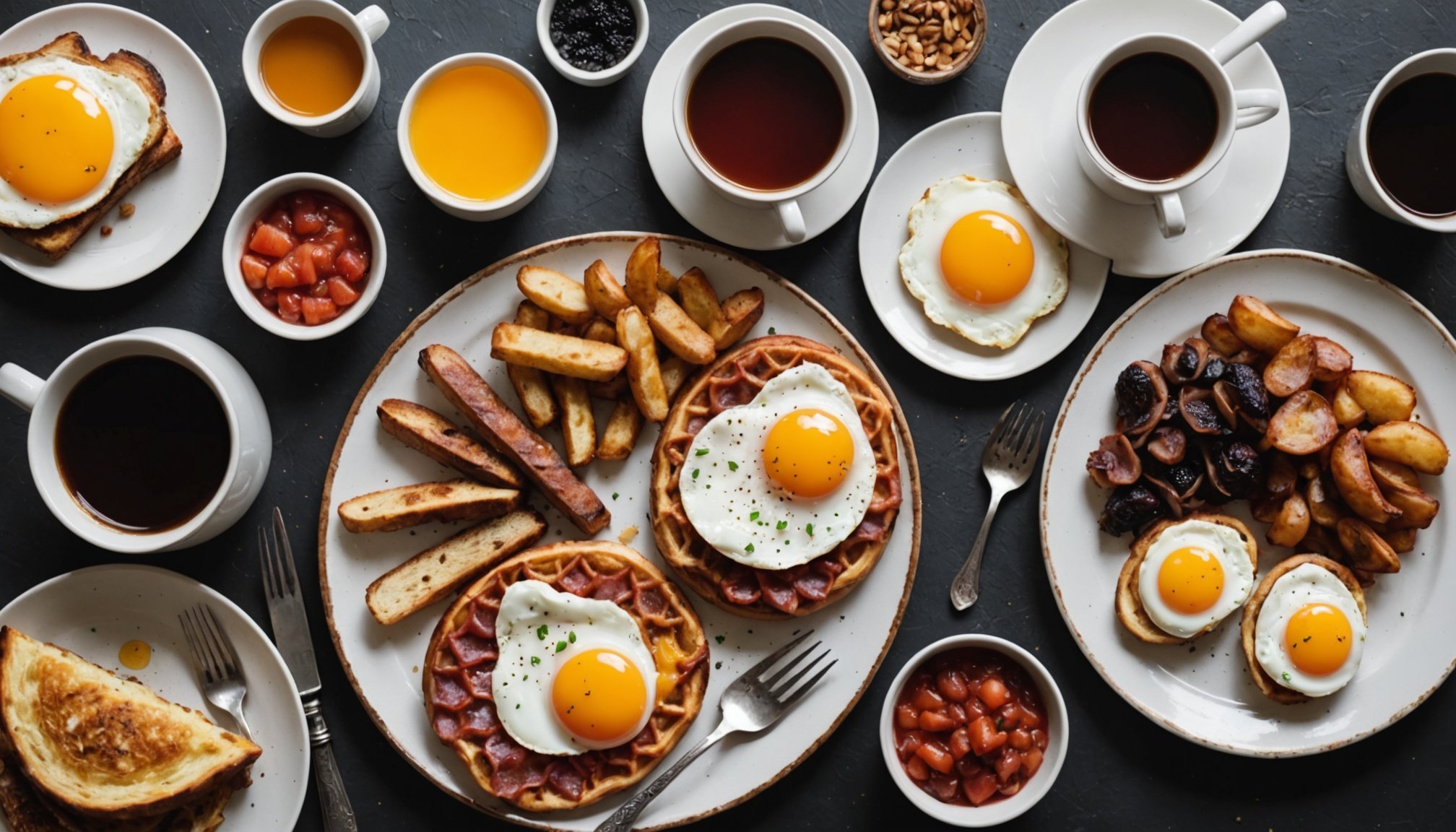Unlocking Taste Perfection: The Definitive Guide to Crafting a Classic English Breakfast
The History and Significance of the English Breakfast
The English breakfast, often referred to as a “full English breakfast” or “fry-up,” has a rich history that dates back to the 18th century. This hearty meal was initially a staple of the wealthy, but over time, it became a beloved tradition across all social classes. The idea behind this substantial breakfast was to provide a filling and energizing start to the day, especially for those engaged in physical labor.
“It’s a meal that’s deeply rooted in British culture,” says Chef Emma Taylor, a renowned expert in traditional British cuisine. “The English breakfast is more than just a meal; it’s an experience that brings people together.”
Have you seen this : Unlocking Perfection: The Ultimate Guide to Creating the Tangy-Sweet English Gooseberry Fool!
Key Components of a Classic English Breakfast
A traditional English breakfast typically includes a variety of components, each contributing to the overall flavor and satisfaction of the meal. Here are the key ingredients you’ll need:
The Essentials
- Bacon: Preferably thick-cut and smoked for added flavor.
- Sausages: Pork sausages are the most common, but you can also use Cumberland or Lincolnshire sausages for a regional twist.
- Eggs: Fried, scrambled, or poached; eggs are a central part of the English breakfast.
- Black Pudding: A type of sausage made from pork blood, oatmeal, and spices.
- Baked Beans: While not traditional in all regions, baked beans have become a popular addition in many modern English breakfasts.
- Mushrooms: Button or portobello mushrooms, often grilled or sautéed.
- Tomatoes: Fresh tomatoes, grilled or fried.
- Toast: Often served with butter and sometimes accompanied by toast with marmalade or jam.
- Tea: Black tea, such as Earl Grey or English Breakfast tea, is the traditional choice.
Preparing the Perfect English Breakfast
Cooking the Bacon and Sausages
To start, cook your bacon and sausages in a non-stick pan over medium heat. Here’s a step-by-step guide:
This might interest you : Unlocking the Secrets to Perfectly Flaky and Buttery English Sausage Rolls: Your Comprehensive Guide
- Bacon: Lay the bacon slices in the pan and cook for about 4-5 minutes on each side, until crispy and golden brown.
- Sausages: Cook the sausages for about 5-7 minutes on each side, ensuring they are cooked through and slightly browned.
Preparing the Eggs
Eggs can be cooked in various ways, but here’s how to make perfect fried eggs:
- Heat a Non-Stick Pan: Over medium heat, add a small amount of butter or oil.
- Crack the Eggs: Gently crack the eggs into the pan.
- Cook: Cook for about 2-3 minutes, until the whites are set and the yolks are cooked to your desired doneness.
Cooking the Black Pudding and Baked Beans
- Black Pudding: Slice the black pudding and cook it in the pan for about 3-4 minutes on each side, until it’s crispy on the outside and warm through.
- Baked Beans: Heat the baked beans in a saucepan over low heat or in the microwave according to the package instructions.
Preparing the Mushrooms and Tomatoes
- Mushrooms: Clean and slice the mushrooms. Cook them in a pan with a bit of butter or oil until they’re tender and lightly browned.
- Tomatoes: Cut the tomatoes in half and cook them in the pan with the mushrooms until they’re soft and slightly caramelized.
The Art of Baking: Adding a Touch of Homemade Goodness
While the English breakfast is primarily about frying and grilling, adding some baked elements can elevate the meal. Here are a few ideas:
Homemade Bread
Baking your own bread can add a personal touch to your breakfast. Here’s a simple recipe for a classic white bread:
Ingredients:
- 2 cups purpose flour
- 1 teaspoon baking powder
- 1 teaspoon baking soda
- 1 teaspoon salt
- 1 tablespoon sugar
- 1 packet active dry yeast
- 1 cup warm water
- 2 tablespoons butter, melted
Instructions:
1. Mix dry ingredients.
2. Add yeast to warm water and let it sit for 5 minutes.
3. Combine wet and dry ingredients.
4. Knead the dough for 10 minutes.
5. Let it rise for 1 hour.
6. Bake at 375°F (190°C) for 30-40 minutes.
French Toast
For a sweet addition, consider making French toast:
Ingredients:
- 4 slices of bread
- 2 eggs
- 1 cup milk
- 1/4 cup sugar
- 1/4 teaspoon cinnamon
- Butter or oil for frying
Instructions:
1. Mix eggs, milk, sugar, and cinnamon.
2. Dip bread slices into the mixture.
3. Fry in a non-stick pan until golden brown.
The Importance of Tea in the English Breakfast Experience
Tea is an integral part of the English breakfast tradition. Here are a few popular tea options:
Black Tea
- Earl Grey: Known for its bergamot flavor, Earl Grey adds a citrusy twist to the classic black tea.
- English Breakfast: A strong and full-bodied tea, perfect for a morning pick-me-up.
Green Tea and Herbal Tea
While not traditional, green tea and herbal tea can offer a lighter alternative for those looking for a different flavor profile.
Tips for the Perfect Breakfast Experience
Timing is Everything
To ensure that all components are ready at the same time, here’s a suggested timeline:
- 30 minutes before serving: Start cooking the bacon and sausages.
- 20 minutes before serving: Prepare the eggs, black pudding, and baked beans.
- 15 minutes before serving: Cook the mushrooms and tomatoes.
- 10 minutes before serving: Toast the bread and prepare any additional items like French toast.
Using the Right Tools
- Non-Stick Pans: Essential for preventing food from sticking and making cleanup easier.
- Cast Iron Skillet: Ideal for cooking multiple items at once and maintaining even heat.
Maintaining the Right Temperature
- Room Temperature: Ensure all ingredients are at room temperature before cooking to achieve even cooking.
- Pan Temperature: Keep the pan at a medium heat to prevent burning and ensure even cooking.
Practical Insights and Actionable Advice
Make Sure to Use Fresh Ingredients
Fresh ingredients make a significant difference in the flavor and quality of your English breakfast. Here’s why:
- Better Flavor: Fresh ingredients have more vibrant flavors that enhance the overall taste of the meal.
- Healthier Options: Fresh ingredients are generally healthier and less processed.
Don’t Overcomplicate the Recipe
While it’s tempting to add too many ingredients, remember that simplicity is key. Here’s what Chef Emma Taylor advises:
“Stick to the classics. The beauty of an English breakfast lies in its simplicity and the quality of its ingredients. Don’t overcomplicate it with too many extras.”
A Comprehensive Table: Comparing Different English Breakfast Variations
Here’s a table comparing different variations of the English breakfast, highlighting key components and regional differences:
| Variation | Bacon | Sausages | Eggs | Black Pudding | Baked Beans | Mushrooms | Tomatoes | Toast | Tea |
|---|---|---|---|---|---|---|---|---|---|
| Full English | Yes | Yes | Yes | Yes | Yes | Yes | Yes | Yes | Black Tea |
| Scottish Breakfast | Yes | Yes | Yes | Yes | No | Yes | Yes | Yes | Black Tea |
| Welsh Breakfast | Yes | Yes | Yes | No | No | Yes | Yes | Yes | Black Tea |
| Vegetarian English | No | No | Yes | No | Yes | Yes | Yes | Yes | Herbal Tea |
Unlocking the Secrets to a Perfect English Breakfast
Crafting the perfect English breakfast is about balance, timing, and using high-quality ingredients. Here are some final tips to help you unlock the secrets:
Balance the Flavors
Ensure that each component complements the others without overpowering them. For example, the smokiness of the bacon should balance the richness of the sausages.
Pay Attention to Texture
A good English breakfast should have a variety of textures – crispy bacon, soft eggs, and tender mushrooms.
Make it a Family Affair
Involve your family in the cooking process. It’s a great way to spend quality time together and create lasting memories.
In conclusion, the English breakfast is more than just a meal; it’s an experience that combines tradition, flavor, and family. By following these guidelines and tips, you can create a breakfast that is not only delicious but also memorable. So, start your day off right with a classic English breakfast that will leave you feeling full and satisfied until lunchtime.
Tips for Unlocking Flavor Perfection
Achieving an unforgettable flavour profile in a Classic English Breakfast involves attention to detail in both seasoning and cooking methods. Incorporating thoughtful cooking tips can elevate the breakfast experience.
Begin by enhancing the flavours of eggs through professional cooking tips like using a pinch of salt and pepper before cooking, or even a dash of cream for scrambled eggs to introduce a rich texture. Regarding bacon and sausages, seasoning them during cooking with herbs such as rosemary can provide an aromatic experience.
The ripeness of tomatoes significantly affects their taste. Consider grilling them with a sprinkle of salt and a hint of olive oil for added sweetness and depth. Beans can be elevated with a dash of Worcestershire sauce or a pinch of spice for a piquant twist.
Maximizing flavours also involves prioritizing fresh, quality ingredients to preserve natural taste. The use of garden-fresh herbs and meticulously selected spices can transform each component. These simple yet effective strategies can create a harmonious breakfast, prompting a deep appreciation of traditional English cuisine.





